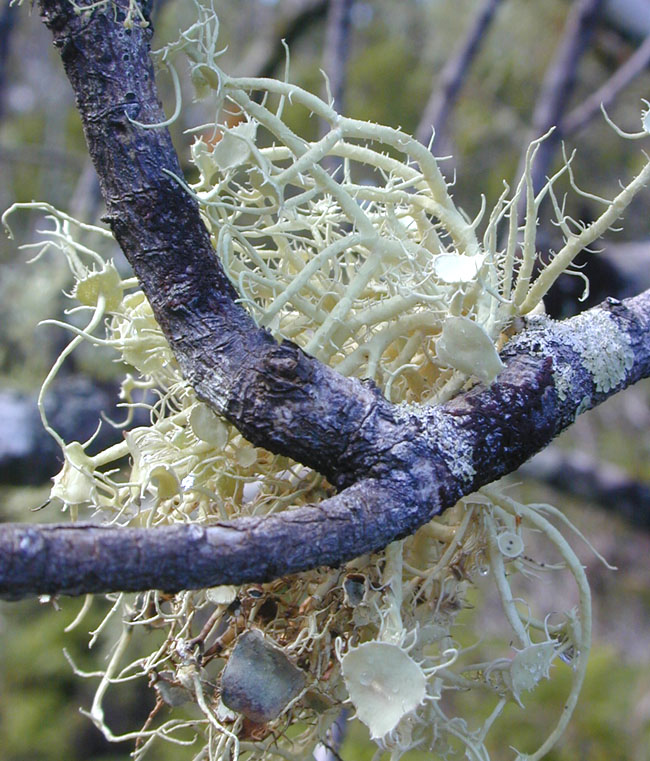- Usnea
Taxobox | name = "Usnea"

image_width = 240px
image_caption = "Usnea australis"
regnum =Fungi
divisio =Ascomycota
classis =Lecanoromycetes
ordo =Lecanorales
familia =Parmeliaceae
genus = "Usnea"
subdivision_ranks = Species
subdivision = See text."Usnea" is the generic and scientific name for several species of
lichen in the familyParmeliaceae , that generally grow hanging from tree branches, resembling grey or greenish hair. It is sometimes referred to commonly as Old Man's Beard, Beard Lichen, or Treemoss. Usnea looks very similar toSpanish moss , so much so that the latter plant's Latin name is derived from it ("Tillandsia usneoides ", the 'Usnea-likeTillandsia ')."Usnea" grows all over the world. Like other lichens it is a
symbiosis of afungus and analga . The fungus belongs to the divisionAscomycota , while the alga is a member of the divisionChlorophyta .Many species have been described. A monography by
Józef Motyka from 1947 distinguished 451 species. Many of these are now regarded as morphological varieties and adaptations to local circumstances. The taxonomic categorization of many members of this genus remains uncertain. The number of recognized species inFinland is decreasing for this reason, from 34 in 1951 to 25 in 1963 and only 12 in 2000. It is now noted as including more than 600 species and being one of the largest genera within the Parmeliaceae.(Ref. Wirtz, N. "et al" 2006.)"Usnea" is very sensitive to air pollution, especially
sulfur dioxide . Under bad conditions they may grow no larger than a few millimetres, if they survive at all. Where the air is unpolluted, they can grow to 10-20 cm long."Usnea" has been used medicinally for at least 1000 years.
Usnic acid (C18H16O7), a potentantibiotic and antifungal agent is found in most species. This, combined with the hairlike structure of the lichen, means that "Usnea" lent itself well to treating surface wounds when sterile gauze and modern antibiotics were unavailable. It is also edible and high invitamin C .This lichen, promoted to induce weight loss via increase in metabolic rate, has been the topic of [http://www.cfsan.fda.gov/~dms/ds-lipo.html an FDA warning] in the USA, due to hepatotoxicity in a product called Lipokinetix. Lipokinetix also contained PPA, caffeine, yohimbine and diiodothyronine. There is no scientific information on the safety or efficacy of oral use of Usnea.
Uses
Usnea lichen is important to note because it has life-saving potential. Native Americans employed it as a compress to severe battle wounds to prevent infection and gangrene, and it was also taken internally to fight infections. Usnea contains potent antibiotics which can halt infection and are broad spectrum and effective against all gram-positive and tuberculosis bacterial species. Usnea has several unique characteristics which make its identification easy if stranded in the wilderness far from a hospital. Usnea lichens can be easily identified by pulling back the outer sheath on the main stem. Usnea lichens have an elastic "pure white" chord running through the center of the main stem. Lichen species which resemble Usnea do not have this white cord, and appear grey-green throughout. Usnea lichens do not change color throughout the growing season as do lichen species which closely resemble Usnea.
pecies
Some of the species of "Usnea" include:
*"Usnea barbata"
*"Usnea dasypoga"
*"Usnea florida"
*"Usnea hirta"
*"Usnea longissima"
*"Usnea rubicunda "
*"Usnea rubiginea"
*"Usnea subfloridana"References
Kirtz, N., Printzen, C., Sancho, L.G. and Lumbsch, H.T. 2006. The phylogeny and classification of "Neuropogon" and "Usnea" (Parmeliaceae, Ascomycota) revisited. "Taxon" 55(2):367 - 376.
* Edible and Medicinal plants of the West, Gregory L. Tilford, ISBN 0-87842-359-1* [http://www.cfsan.fda.gov/~dms/ds-ltr25.html FDA letter to Health Care Professionals] on Hazardous Dietary Supplement Lipokinetix, 2001-11-01
External links
* Pekka Halonen, [http://herkules.oulu.fi/isbn9514255240/isbn9514255240.pdf Studies on the lichen genus "Usnea"] in East Fennoscandia and Pacific North America (PDF)
Wikimedia Foundation. 2010.
